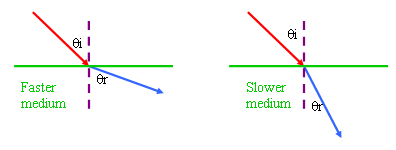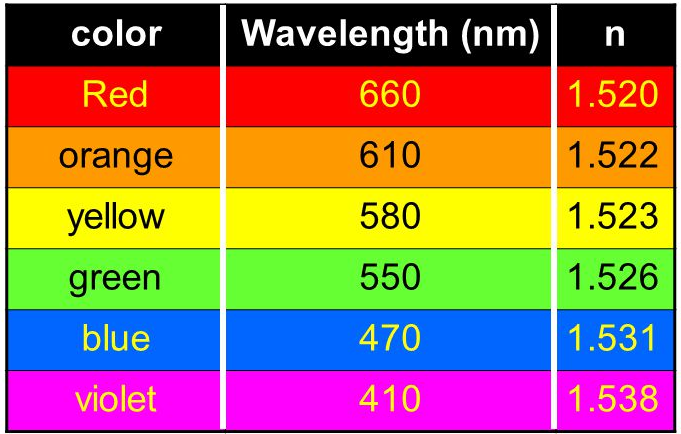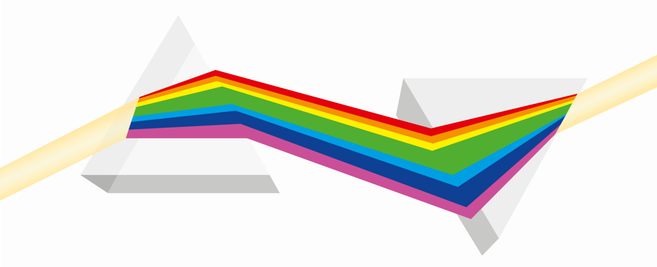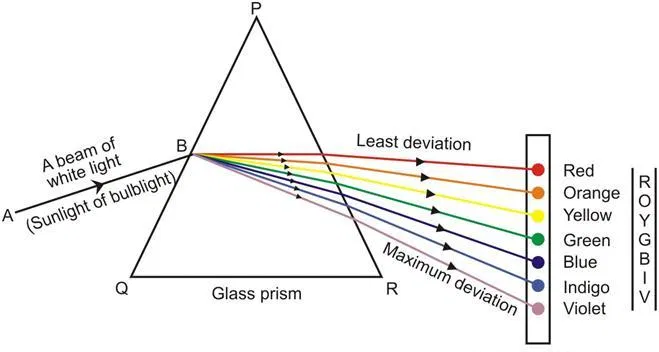How Do We See Colour?
Objects do not actually have colour. What we see as the colour of an object is due to the way that the object interacts with light and ultimately reflects or transmits it to our eyes.
An object contains atoms that might be capable of selectively absorbing one or more frequencies of the visible light that strikes it. When visible light strikes an object and a specific frequency is absorbed, that frequency of light will never make it to our eyes.
Only the visible light that strikes the object and becomes reflected or transmitted to our eyes will contribute to the colour appearance of that object.


If a ladybug shell absorbs all of the frequencies of visible light except for the frequency associated with red light, then the ladybug will appear red.
If a leaf absorbs all of the frequencies of visible light except for the frequency associated with green light, then the leaf will appear greeen.
Do Colours Bend?
Light traveling through a medium, propagates in a straight line and at a relatively constant speed, unless it is disturbed in some manner. This depends on two key factors: the optical density of the medium AND the frequency of the light wave.
🌈The optical density of a medium is the medium’s ability to slow down the light which passes through it. More optically dense materials will cause light to travel slower in it, and less optically dense materials will cause light to travel faster in it.
The optical density of a material relates to the sluggish tendency of the atoms of a medium to transfer energy between each other. In every medium, other than a vacuum (a perfect particle-free medium), there is a relative time delay as this energy is passed along.

This relative speed is called the index of refraction (n), ie., the number of times slower that a wavelength will travel in a given medium in comparison to a vacuum (which has the lowest possible optical density). For example, the refractive index of water is 1.3, meaning that light will travel 1.3x slower in water than in a vacuum.

Practically speaking, light travels at approximately 300,000 km/sec., in a vacuum (n = 1.0). It slows down to 225,000 km/sec in water ( n = 1.3) and 200,000 kilometers per second in glass (n = 1.5). In diamond (n = 2.4), the speed of light is reduced to 125,000 km/sec.
The term refraction refers to the bending of the path of a light wave as it passes from one medium to another. Refraction occurs at the boundary of the mediums and is caused by a change in the speed of the light wave upon crossing the boundary. Whether a light wave bends towards or away from the “normal” (an imaginary line drawn perpendicular to the boundary) depends on whether the light wave slows down or speeds up upon crossing the boundary.

🌈The speed that light travels in a medium depends on more than just the optical density of the medium. It is also dependent on the colour (frequency) of said light.

In any given medium, other than a vacuum, light waves with higher f (shorter λ) will travel slower than light with lower f (longer λ). Hence, why violet has a higher refractive index than red.
Why? Because higher frequency particle motion takes more energy and thus slows down propagation.
Newton’s Rainbow
These two concepts are the basics of what underpins Newton’s prism experiment – the experiment where he used glass pyramids to separate white light into a spectrum of different colours and then back into a beam of white light.

As white light enters a prism, it slows down (since glass has a higher refractive index than air) and so refracts towards the normal. Because the different wavelengths of visible light have different indices of refraction, every “colour” will refract at a slightly different angle. A similar phenomenon occurs when light exits the prism. In this case, as light reaches the glass-air boundary, it speeds up (since air has a lower refractive index than glass) and so refracts away from the normal. Again, the individual colours will all refract at slightly different angles. Colours that have higher f (shorter λ) will deviate from their original path – refract – more than the colours with lower f (longer λ).
This dispersion of the different colours of light at different angles is why an observer sees visible light separated into its component colours.

In Newton’s actual experiment, he used two prisms. The first to separate white light into its component colours and then a second to recompose the colours back into white light.


